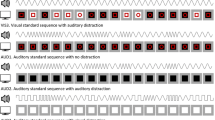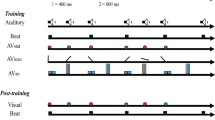Abstract
Our perception of time is affected by the modality in which it is conveyed. Moreover, certain temporal phenomena appear to exist in only one modality. The perception of temporal regularity or structure (e.g., the ‘beat’) in rhythmic patterns is one such phenomenon: visual beat perception is rare. The modality-specificity for beat perception is puzzling, as the durations that comprise rhythmic patterns are much longer than the limits of visual temporal resolution. Moreover, the optimization that beat perception provides for memory of auditory sequences should be equally relevant to visual sequences. Why does beat perception appear to be modality specific? One possibility is that the nature of the visual stimulus plays a role. Previous studies have usually used brief stimuli (e.g., light flashes) to present visual rhythms. In the current study, a rotating line that appeared sequentially in different spatial orientations was used to present a visual rhythm. Discrimination accuracy for visual rhythms and auditory rhythms was compared for different types of rhythms. The rhythms either had a regular temporal structure that previously has been shown to induce beat perception in the auditory modality, or they had an irregular temporal structure without beat-inducing qualities. Overall, the visual rhythms were discriminated more poorly than the auditory rhythms. The beat-based structure, however, increased accuracy for visual as well as auditory rhythms. These results indicate that beat perception can occur in the visual modality and improve performance on a temporal discrimination task, when certain types of stimuli are used.




Similar content being viewed by others
References
Averbach E, Coriell E (1961) Short-term memory in vision. Bell Syst Tech J 40:309–328
Chen Y, Repp BH, Patel AD (2002) Spectral decomposition of variability in synchronization and continuation tapping: comparisons between auditory and visual pacing and feedback conditions. Hum Movement Sci 21:515–532
Collier GL, Logan G (2000) Modality differences in short-term memory for rhythms. Mem Cognition 28:529–538
Collier GL, Wright CE (1995) Temporal rescaling of simple and complex ratios in rhythmic tapping. J Exp Psychol Human 21:602–627
Cowan N (1984) On short and long auditory stores. Psychol Bull 96:341–370
Crowder RG (1982) Decay of auditory memory in vowel discrimination. J Exp Psychol Learn Mem Cogn 8:153–162
Darwin CJ, Turvey MT, Crowder RG (1972) An auditory analogue of the Sperling partial report procedure: evidence for brief auditory storage. Cognit Psychol 3:255–267
Drake C, Penel A, Bigand E (2000) Tapping in time with mechanically and expressively performed music. Music Percept 18:1–24
Eriksen CW, Collins JF (1967) Some temporal characteristics of visual pattern perception. J Exp Psychol 74:476–484
Essens PJ (1995) Structuring temporal sequences: comparison of models and factors of complexity. Percept Psychophys 57:519–532
Essens PJ, Povel DJ (1985) Metrical and nonmetrical representations of temporal patterns. Percept Psychophys 37:1–7
Ferrandez AM, Hugueville L, Lehéricy S et al (2003) Basal ganglia and supplementary motor area subtend duration perception: an fMRI study. NeuroImage 19:1532–1544
Gault RH, Goodfellow LD (1938) An empirical comparison of audition, vision, and touch in the discrimination of temporal patterns and ability to reproduce them. J Gen Psychol 18:41–47
Glenberg AM, Jona M (1991) Temporal coding in rhythm tasks revealed by modality effects. Mem Cogn 19:514–522
Glenberg AM, Mann S, Altman L, Forman T (1989) Modality effects in the coding and reproduction of rhythms. Mem Cogn 17:373–383
Goldstone S, Lhamon WT (1972) Auditory-visual differences in human temporal judgment. Percept Motor Skills 34:623–633
Grahn JA (2009) The role of the basal ganglia in beat perception: neuroimaging and neuropsychological investigations. Ann NY Acad Sci 1169:35–45
Grahn JA, Brett M (2007) Rhythm perception in motor areas of the brain. J Cogn Neurosci 19:893–906
Grahn JA, Brett M (2009) Impairment of beat-based rhythm discrimination in Parkinson’s disease. Cortex 45:54–61
Grahn JA, Henry MJ, McAuley JD (2011) FMRI investigation of cross-modal interactions in beat perception: audition primes vision, but not vice versa. NeuroImage 54:1231–1243
Grondin S (1993) Duration discrimination of empty and filled intervals marked by auditory and visual signals. Percept Psychophys 54:383–394
Grondin S, Meilleur-Wells G, Ouellette C, Macar F (1999) Sensory effects on judgements of short time-intervals. Psychol Res 61:261–268
Guttman SE, Gilroy LA, Blake R (2005) Hearing what the eyes see: auditory encoding of visual temporal sequences. Psychol Sci 16:228–265
Handel S, Buffardi L (1969) Using several modalities to perceive one temporal pattern. Q J Exp Psychol 21:37–41
Holcombe AO (2009) Seeing slow and seeing fast: two limits on perception. Trends Cogn Sci 13:216–221
Hove MJ, Spivey MJ, Krumhansl CL (2010) Compatibility of motion facilitates visuomotor synchronization. J Exp Psychol Human 36:1525–1534
Jäncke L, Loose R, Lutz K, Specht K, Shah NJ (2000) Cortical activations during paced finger-tapping applying visual and auditory pacing stimuli. Cog Brain Res 10:51–66
Jantzen KJ, Steinberg FL, Kelso JAS (2005) Functional MRI reveals the existence of modality and coordination-dependent timing networks. NeuroImage 25:1031–1042
Large EW, Palmer C (2002) Perceiving temporal regularity in music. Cogn Sci 26:1–37
McAuley JD, Henry MJ (2010) Modality effects in rhythm processing: auditory encoding of visual rhythms is neither obligatory nor automatic. Atten Percept Psycho 72:1377–1389
Nettl B (2000) An ethnomusicologist contemplates universals in musical sound and musical culture. In: Wallin NL, Merker BH, Brown S (eds) The origins of music. MIT Press, Cambridge, MA, pp 463–472
Parncutt R (1994) A perceptual model of pulse salience and metrical accent in musical rhythms. Music Percept 11:409–464
Patel AD, Iversen JR, Chen Y, Repp BH (2005) The influence of metricality and modality on synchronization with a beat. Exp Brain Res 163:226–238
Povel DJ, Essens PJ (1985) Perception of temporal patterns. Music Percept 2:411–440
Povel DJ, Okkerman H (1981) Accents in equitone sequences. Percept Psychophys 30:565–572
Repp BH, Penel A (2002) Auditory dominance in temporal processing: new evidence from synchronization with simultaneous visual and auditory sequences. J Exp Psychol Human 28:1085
Sakitt B (1976) Iconic memory. Psychol Rev 83:257–276
Schubotz RI, Friederici AD, von Cramon DY (2000) Time perception and motor timing: a common cortical and subcortical basis revealed by fMRI. NeuroImage 11:1–12
Schutz M, Kubovy MJ (2009) Causality and cross-modal integration. J Exp Psychol Hum Percept Perform 35:1791–1810
Semjen A, Ivry RB (2001) The coupled oscillator model of between-hand coordination in alternate-hand tapping: a reappraisal. J Exp Psychol Human 27:251–265
Shih LYL, Kuo W-J, Yeh T-C et al (2009) Common neural mechanisms for explicit timing in the sub-second range. NeuroReport 20:897–901
Sperling G (1960) The information available in brief visual presentation. Psychol Monogr 74:1–29
Stauffer CC, Haldemann J, Troche SJ, Rammsayer TH (2012) Auditory and visual temporal sensitivity: evidence for a hierarchical structure of modality-specific and modality-independent levels of temporal information processing. Psychol Res 76:20–31
van Noorden L, Moelants D (1999) Resonance in the perception of musical pulse. J New Music Res 28:43–66
Wiener M, Turkeltaub P, Coslett HB (2010) The image of time: a voxel-wise meta-analysis. NeuroImage 49:1728–1740
Author information
Authors and Affiliations
Corresponding author
Rights and permissions
About this article
Cite this article
Grahn, J.A. See what I hear? Beat perception in auditory and visual rhythms. Exp Brain Res 220, 51–61 (2012). https://doi.org/10.1007/s00221-012-3114-8
Received:
Accepted:
Published:
Issue Date:
DOI: https://doi.org/10.1007/s00221-012-3114-8




